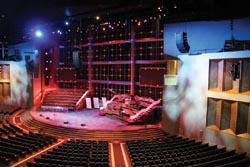- The Pinnacle Hills worship center is headed by a large front platform, with theater-style padded seating fanning outward to the rear wall to create an exceptionally wide coverage area.ROGERS, AR-The new Church of Pinnacle Hills in Rogers, AR, is highlighted by a 2,380-seat sanctuary outfitted with a sophisticated sound system design that enhances the church's dynamic contemporary worship services. Acoustic Dimensions of Dallas provided the AV design, with Clair Brothers Audio of Nashville responsible for installation. Both firms worked closely with church technical/musical staff in the successful completion of the project.
- The Pinnacle Hills worship center is headed by a large front platform, with theater-style padded seating fanning outward to the rear wall to create an exceptionally wide coverage area. A balcony spans above the rear seating sections, with future plans calling for seating expansion (up to approximately 3,000 seats) beyond the current back wall.
- Acoustic Dimensions elected to deploy a "mono plus stereo" design. Dual EAW KF730 line arrays flown centrally above the platform are fed spoken word, music vocals and primary instruments (rhythm, drums, and guitars to a large extent) for a highly coherent, natural presentation. Single EAW MQ Series installation loudspeakers fill slight gaps at the extreme sides.
- Flanking out to the extreme left and right of the platform, EAW KF761 large, wide-coverage line arrays provide textures that can dramatically enhance musical programming, resulting in a kind of surround approach. These are largely generated with pre-produced samples, tracks, and live "pads and tones" generated by keyboard player Jonathan Walker. No delay loudspeakers are needed to extend coverage to the rear-most seats.
- Standing 60 feet tall behind the front platform, a tinted glass wall presented a significant challenge-it could act as a giant reflector, sending energy off the back of the main loudspeaker arrays back into the room to a detrimental degree. As a result, Acoustic Dimensions specified separate line arrays behind the KF730s that, with the aid of digital signal processing, creates a cardioid effect that provides significant cancellation of energy coming off the back of the array enclosures.
- "It's not quite a true cardioid plane curve, but it still is able to eliminate up to 8 dB of energy coming off the back of the loudspeakers, and thus making a significant change for the better in the reverberant field," explained Acoustic Dimensions' Ryan Knox. "The difference can most certainly be heard when the rear arrays are turned on and off."
Dual EAW KF730 line arrays flown centrally above the front platform are fed spoken word, music vocals and primary instruments for a highly coherent, natural presentation.
All loudspeakers, including custom EAW triple-15-inch-loaded subwoofers, are driven by Lab.gruppen power amplifiers split between two remote equipment rooms. The house console is a Yamaha PM1D, with an Optocore fiber optic feed to the facility's extensive production/recording facilities.
The sound team also deployed new EAW UX8800 dual-mode digital processors; in fact, the project marks one of the earliest house of worship applications of this new technology. The UX8800 is designed to function as an overall system manager, processor, and controller, while its Gunness Focusing alignment and driver processing algorithms dramatically enhance the performance of a growing number of EAW loudspeakers, including the models utilized at the Pinnacle Hills worship center.
"Both arrays exhibit a neutral and natural character that I haven't heard previously with other line arrays," Knox said. "The arrays are also very responsive to EQ both in the DSP and on the console channel strips. Overall, much less channel EQ is used and the 60-70 channel mix is less cluttered."
The processing set also includes BSS Soundweb London units for control and routing, in addition to providing single feeds to the UX8800s, which in turn supply HF, MF, and LF feeds back to London and on to the loudspeakers. In fact, the system was utilized with alternative processing for several weeks prior to the UX8800s coming to market.










